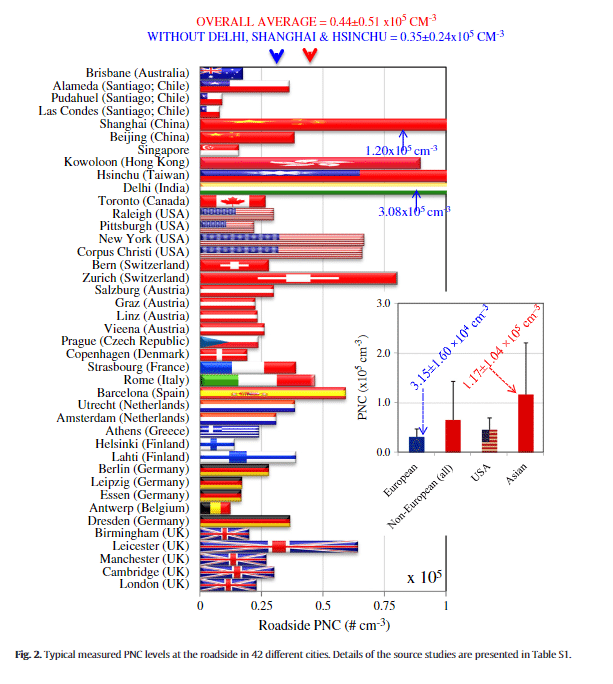We care about clean air
solutions for indoor air quality
Quick to: measure fine dust yourself
What is the ultrafine dust standard in the Netherlands?
People are becoming more aware of how dangerous ultrafine dust particles are for your health. It’s like an assassin that makes many people sick who live and work in busy areas with a lot of industry, highways and traffic. Ultrafine dust increases the risk of high blood pressure, heart problems and lung cancer. This is shown by ultrafine dust research by the Health Council. You can read about the research in this blog.
With a PM meter (fine dust meter) you can measure how much fine dust is in the air. However, you may ask yourself from what concentration ultrafine dust particles are dangerous to your health and whether a fine dust standard or an ultrafine dust standard has been drawn up in the Netherlands. We did some investigating on these matters.
What is the difference between fine dust and ultrafine dust?
We include all particles in the air smaller than 10 micrometers (10 µm) as fine dust. When we measure fine dust, it’s often abbreviated to PM(particulate matter aka fine dust). The two main sizes are PM10 and PM2.5. PM10 has a size of up to 10 µm and PM2.5 has a size of up to 2.5 µm.
Particles smaller than 0.1 µm are referred to as ultrafine particles. Ultrafine dust particles are the most dangerous to our health. When inhaled, these tiny particles penetrate the lungs and are absorbed directly into the bloodstream.
Is there an official ultrafine dust standard?
No official standards have been drawn up for ultrafine dust yet. In September 2019, the Dutch Cabinet urged the Health Council to investigate and draw up an ultrafine dust standard. Because around 11,000 people in the Netherlands die prematurely each year as a result of exposure to (ultra)fine dust. However, it’s still not clear when the investigation will officially start or end.
However, a fine dust standard has been drawn up for PM10 and PM2.5. The RIVM has determined that 40 µg / m³ is the annual average limit value for PM10. For PM2.5 this is 20 µg / m3.
Is it possible to measure ultrafine dust?
According to RIVM, measuring extremely small particles is very difficult because it’s hard to detect a particle with a size of a few nanometers. A so-called Condensation Particle Counter can measure ultrafine dust particles, but they are a bit out of reach for the average consumer since the devices cost several thousand euros.
A more affordable option is using a fine dust meter. You can measure fine dust particles PM2.5 and PM10 with it. When the concentrations of these values exceed the norm, you can assume that the concentration of ultrafine dust is also unhealthy.
Investigations into the measurement of ultrafine dust
As you know, all dust particles below 0.1 micron are ultrafine dust particles. Ultrafine dust particles are measured by scientists in nanometers. 0.1 micrometers is 100 nanometers. So all particles below 100 nanometers (nm) are considered ultrafine dust particles.
There are some studies that have measured ultrafine dust concentrations in cities. Such as a study from the National Technical University of Athens. Between 2003 and 2004, they measured the ultrafine dust concentration at various locations in Athens. The highest outdoor measurements were found in the air at two schools, both of which were located and affected by a busy road. In the first school, 36,900 ultrafine dust particles per cm3 in the air were detected and in the second school 38800 ultrafine dust particles per cm3. According to the ultrafine dust research, the results provide insight into the concentration level to which children can be exposed.
The morning rush hour is the most unhealthy time of the day
The University of Helsinki studied the air quality in their city between 1999 and 2003. The research team concluded that the air in the city is dirtier in winter than in summer. The highest concentrations of ultrafine dust were detected during busy traffic hours. The average peak concentration during the morning rush hour was no less than 40,000 per cm3 in the city. Most of the traffic-induced ultrafine dust particles were smaller than 50 nm. Particles below 10 nm were also detected. In their research, the Finns warn about the health effects of such small particles.
A more recent study from Environment International in 2014 examined the ultrafine dust levels along the road in 42 different cities. The farther from a road was measured, the less ultrafine dust particles in the air were detected. The highest concentration of ultrafine dust particles was measured in a busy car tunnel. The research shows that the air along a road in a European city contains an average of 16,000 to 31,500 ultrafine dust particles per cm3.

Source chart: Ultrafine dust research
Environment International’s research made a chart with the average measured ultrafine dust particles (3 to 25 nm) per cm3 in different cities. PNC means particle numbers count, in other words: how many ultrafine dust particles have been counted. The chart shows that along the roads in Amsterdam there are on average around 3000 ultrafine dust particles per cm3. This is a high figure compared to the average European city. We can therefore assume that Amsterdam is relatively unhealthy in the field of ultrafine dust particles.
Need advice or more information?
According to The Dutch Lung Fund(Longfonds), the air quality in 1 in 7 houses is insufficient due to fine dust. By measuring fine dust you can gain insight into the air quality of your environment. You also determine the effectiveness of your air purifier. View our product page about the fine dust meter or read more about the fine dust meter in our extensive advice. Do you have any further questions or would you like some free personal advice? Call +31 20 6464028 or go directly to our range of fine dust meters:

